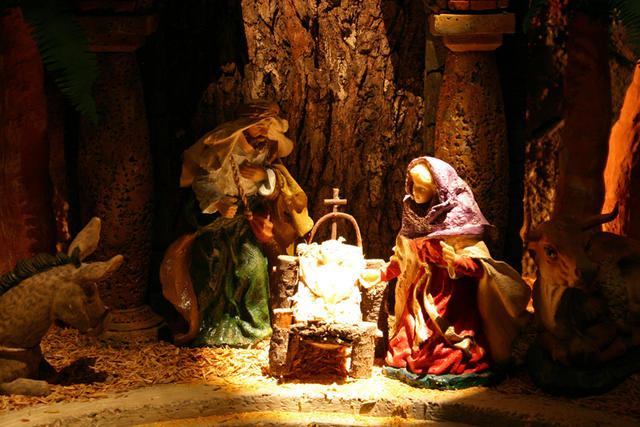The Birth of the Nativity Scene
Posted on the Internet 12 December, 2011
Though the beautiful narrative of Christ’s nativity appears in the gospels of Saints Matthew and Luke, His birth was not widely celebrated nor did it enter the liturgical cycle until the 3rd or 4th century. Ancient Christians were more inclined to focus on the Epiphany, the arrival of the Magi, than the birth of Christ. In his Homilies on Leviticus, Origen, a 2nd century theologian, remarked that “only sinners” marked the day of their birth, citing evil rulers like the Egyptian pharaoh and Herod as examples of vain birthday celebrations. In fact, rather than celebrate birth, it was the tradition of the Church to commemorate the deaths of martyrs and Christian faithful with feast days, so it is not surprising that the Nativity of Christ was unremarked in the earliest centuries of the Faith.
Depictions of the Nativity of the Divine Child appear during the period when the Church first began to widely observe the feast of Christ’s birth on December 25th. The earliest examples are relief sculptures on sarcophagi in Rome and Gaul. They generally show a swaddled baby surrounded by ox and ass, a common motif based on Isaiah 1:3: “The ox knoweth his owner, and the ass his master’s crib. . .” Some depict the Bethlehem star, the Virgin Mary, the shepherds or Magi and, less often, Joseph. (“Nativity (in Art)“ 1380). The first documented usage of the Nativity in worship occurred in 4th Century Rome at the basilica of Santa Maria Maggiore, where a Christian shrine included boards traditionally associated with the manger which held the Christ Child. One of the three Christmas masses at the basilica was titled Ad Praesepe, or “to the crib” (“Nativity Scene” 407).
Though there are other artistic representations of Christ’s birth carved in ivory, mosaic, and even gems, the modern Nativity scene used in worship, and later in homes, is a direct descendant of a live Nativity conceptualized by St. Francis of Assisi in 1223. Francis received papal approval to celebrate a Christmas mass in the first living Nativity scene, which was erected in a cave at Greccio where a local lord, Giovanni di Velita, had given Francis space for a small hermitage. There, Francis installed a wooden manger with straw. Following earlier iconographic tradition, a live ox and ass were also provided to complete the simple scene. At midnight, worshipers came with torches and lanterns, and a priest conducted a mass over the empty, straw-strewn crib. The spiritual celebration was ecstatically received and represented an innovative and contemplative enhancement of the Midnight Mass (Greene 242-243). The Franciscan Nativity was soon adapted throughout Europe and took on a high level of pageantry and celebration. In French and Italian villages costumed villagers made procession to live Nativities and in some cases brought gifts and offerings to present to the Holy Child, a surrogate for Holy Church. By the sixteenth century, many European churches in France, Germany, and Italy annually reenacted the presepio (crib scene) at Christmas and Epiphany (“Nativity Scene” 408).
In the seventeenth century, versions of the Christmas scene began to appear in homes, some mere folk art and others more developed. In eighteenth century Naples, families competed to construct the most intricate and ostentatious Nativity scenes, which expanded far beyond the Holy Family to include villagers, angels, and elaborate scenery, some boasting working waterfalls or erupting volcanoes. Wealthy Neapolitans sometimes hired professional artists to paint scenery, sculpt heads or create extravagant bejeweled clothing for the figures (“Nativity Scene” 409).
In 1803, the first known portable Nativity set appeared at a Christmas fair in Marseille, France. The small clay figurines represented the usual characters from the biblical account (Mary, Joseph, Jesus, angels, shepherds, and Magi) but also included a variety of tradespeople such as a baker, fishmonger, mayor and others. When French migrants came to Canada, they began the tradition of placing the sets beneath the branches of a Christmas tree (“Nativity Scene” 409).
In England and the American Colonies, Christmas celebrations suffered under the ascetic regulations of the Puritans, who outlawed Christmas commemorations, along with other “Holy-dayes” in June 1647, claiming they had been “superstitiously used and observed” (Grapel 26). The Nativity set, then, did not arrive in America until the eighteenth century, when German Moravian immigrants brought the strong European tradition with them (“Nativity Scene” 411).
In modern times, the Nativity scene is a staple of Christmas commemoration and pageantry. Controversy often surrounds the display of the Gospel tableau in public spaces such as courthouse lawns and schoolyards. Political pundits postulate about the impact on the separation of Church and State, and religious bigots harp about the affront to tolerance and diversity. However, through the efforts of tenacious Christian celebrants, the scenes persist from elegant, artistic representations to live reenactments to kitschy lawn ornaments. The simple scene of St. Francis in the small Italian hermit’s chapel is now a fixture of the Faith. This year remember that each crèche, whether grand or humble, is rooted in ancient Christian worship and reminds us of the divine loftiness and incarnated lowliness of the Blessed Divine Child, Jesus Christ.
Sources:
Grapel, William. Church’s Holy-Days the Only Safeguard Against the Desecration of the Lord’s Day. London: Joseph Masters, 1848.
Green, Julien. God’s Fool: the Life and Times of Francis of Assisi. Trans. Peter Heinegg. San Francisco: Harper & Row, 1983.
“Nativity (in Art).” A Dictionary of Christian Antiquities. Eds. William Smith and Samuel Cheetham. Vol 2. 1880. Print.
“Nativity Scene.” Encyclopedia of Christmas. Ed. Tanya Gulevich. 2000. Print.
